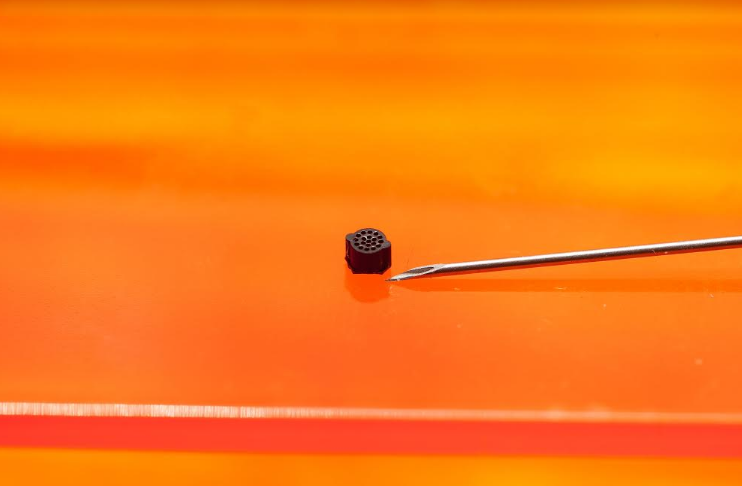Israel’s Nanofabrica is continuing their path to superstardom for manufacturing on the micro and nanoscale. While just recently they released a new platform for micron resolution 3D printing, Nanofabrica is giving us a look into their impact on additive manufacturing in their latest press release regarding micro-optical components.
Their technology and platforms have been successful in numerous industries, with the testing and validation behind their advances as evidence. Their most recent additive manufacturing platform is not only affordable but functions as a real alternative to conventional methods in areas like micro-molding. The concepts and processes they have basically taken off and run with are fascinating but logical—why not use 3D printing to create large volumes of micro-sized parts, with thousands of parts and components all produced in one build. This propels 3D printing and additive manufacturing far from the prototyping and low-batch volume realm, and into that of mass manufacturing.
Nanofabrica also seems to have found their niche in micro-optical parts, comprised of small, flat, complex geometries—and often what is most appealing is the ability to make components that are both strong and extremely lightweight. This potential opens limitless opportunities for those willing to make the jump and the investment in newer technology. Many manufacturers are still completely invested in micro injection molding, and mainly because it was the only best option.
Today, additive manufacturing offers a host of benefits, with lower cost and speed in production topping the list for reasons to switch gears; however, the ability to design, fabricate, and refine parts at will quickly—offers incredible self-sustainability to users on all levels. Both accessibility and affordability are becoming more of a reality around the world, along with specific applications like this AM platform that makes manufacturing possible on a level that many may never have imagined possible—and especially in the medical field for devices like sensors, endoscopes, and imaging applications.
Jon Donner, CEO of Nanofabrica (with a PhD in optics and nano-optics) says, “Currently, most precision optical assemblies are undertaken using precision robotics. With Nanofabrica’s micro AM technology, which is characterized by micron resolution printing capabilities, customers can additively manufacture a jig that allows for precise positioning of optical parts. Currently we have customers using our micro AM platform to make optical connectors and fibers, lenses and prisms, and illumination optics. With continual development of surface finish, we expect to be able to print imaging optics in the very near future.”
Additive manufacturing for micro-optical parts is suitable for creating other parts like:
- Jigs and fixtures for optical alignment
- Optical connectors for optical fibers
- Fiber optic ferrules and other related elements
- Optical elements like lenses and prisms
“Additive manufacturing has many innate advantages as a production tool, among which are the fact that it allows designers to think out of the box when it comes to apparent design restrictions, and of course multiple design iterations can be made speedily to stimulate the creation of innovative end products,” continued Donner. “But until the launch of Nanofabrica’s micro AM production technology, the requirements from the micro optics sector in terms of ultra-precision and repeatable resolution and surface finish were impossible to achieve using 3D printing. Using Nanofabrica’s micro AM platform, OEMs can now in a single process create micro-optical polymer-based products with complexity and features such as freeform surfaces that would either be impossible using conventional manufacturing technologies or be prohibitive in terms of time and cost.”
While 3D printing originated as a technology for engineers, made by engineers, for rapid prototyping, its uses and potential for innovation have proven to be so enticing to users around the world that the creation of and refining of hardware, software, and materials for myriad fabrications has become the subject of countless studies. Better routes to production while continuing to improve on quality and affordability is a running theme, whether researchers are finding ways to make microstructures for optics via 3D printing, offer mass customization, or industry leaders strive to accelerate additive manufacturing.
What do you think of this news? Let us know your thoughts! Join the discussion of this and other 3D printing topics at 3DPrintBoard.com.
[Source / Images: Nanofabrica]Subscribe to Our Email Newsletter
Stay up-to-date on all the latest news from the 3D printing industry and receive information and offers from third party vendors.
You May Also Like
Latest Earnings Overview for Australian 3D Printing Firms Titomic and AML3D
Australian 3D printing manufacturing firms Titomic (ASX: TTT) and AML3D (ASX: AL3) reported their financial results for the period from July to December 2023, marking the first half of their...
Correction: 3D Printing Service Fathom to Merge with CORE Affiliate Amid Financial Challenges
Correction 4/8/24: A previous version of this story incorrectly speculated that Fathom would merge with CORE portfolio company UPTIVE. The article has been updated to remove that reference. As discussed...
3D Printing Financials: Unpacking Farsoon and BLT’s 2023 Performance
In the Chinese 3D printing industry, two companies, Farsoon (SHA: 688433) and Bright Laser Technologies, or BLT (SHA: 688333), have recently unveiled their full-year earnings for 2023. Farsoon reported increases...
3D Printing Financials: Shapeways Faces Challenges Despite Revenue Uptick
Shapeways (BCBA: SHPW) faced a challenging year in 2023, with financial results showing a mix of growth and setbacks. While the company saw an increase in revenue and gross profit,...


































